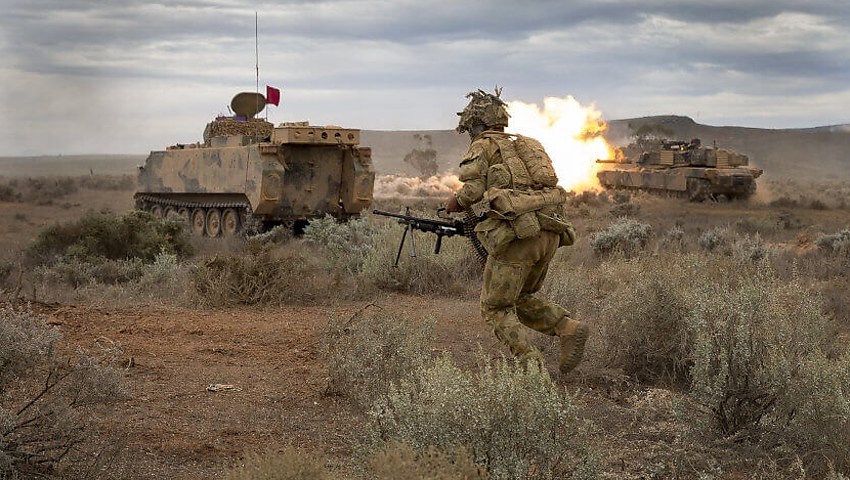A fighting force of tanks, helicopters, armoured reconnaissance vehicles and infantry soldiers have showcased Australian Army’s joint combined arms capabilities during a live fire demonstration at Exercise Chong Ju in Puckapunyal, Victoria.
To continue reading the rest of this article, please log in.
Create free account to get unlimited news articles and more!
Chief of the Australian Army, Lieutenant General Rick Burr, AO, DSC, MVO, said Exercise Chong Ju demonstrated Army’s preparedness for operational deployments, and showcased its capabilities to partners in defence industry.
Spectators witnessed the versatile and decisive force of the Army through a fictional operational scenario that showcased the joint capabilities including M1A1 Abrams tanks, Australian light armoured vehicles (ASLAVs), a M777A2 howitzer, a Tiger armed reconnaissance helicopter and infantry minor team tactics.
"This exercise is an opportunity for Defence leaders and defence industry to see how the Australian Defence Force systems work in unison and the effects on the battlefield in a potential operational scenario," LTGEN Burr said.
The exercise also provided staff cadets of the Royal Military College - Duntroon an opportunity to experience the breadth of roles open to them upon graduation later this year.
LTGEN Burr added, "We are an Army in motion. We are prepared to deploy our versatile capabilities for the joint force, which requires us to be ready to assist in crises here at home and across the globe, now and in the future."
Accelerated Warfare is at the core of the 'Army in motion' concept which identifies the focus points for the future Army, while also identifying the role the force will play as part of the ADF's 'joint force' doctrine in future conflicts. Supporting this, LTGEN Burr identified four key areas of disruption for the Army to face in the coming decades:
- Geopolitics: The Indo-Pacific regional order is defined by a rapidly changing threat environment and operating spectrum of co-operation, competition and conflict. The days of unchallenged coalition operations are quickly fading as state and asymmetric actors all develop capabilities that threaten the natural advantages Australia and its allies have leveraged for supremacy over the past 50 years.
- Threat: Indo-Pacific Asia's operating landscape is changing. Adversaries, including violent extremist organisations and state-based threats can now control and influence all operating domains. Future strike capabilities will not just be physical but also digital, executed often at the speed of a mouse-click. Sophisticated anti-access, area denial (A2/AD) capabilities offer the ability to deny manoeuvre while distributed systems that are ‘smarter’ and smaller are becoming increasingly essential to survivability. Networking will be critical in terms of generating a system capable of ‘co-operative engagement’.
- Technology: As in civilian life, technology is changing the way war is fought. The rapid development turn around of technologies like UAS, the proliferation of non-traditional intelligence gathering devices, the convergence of big data, artificial intelligence, machine learning, robotics and precision strike capabilities all present significant challenges, not only to operations, but to the decision-making process of soldiers and commanders.
- Domains: The reach of sensor and precision fire means Army must be across all domains and comprehensively integrate across them. Space and cyber have not been fully contested in previous wars and there is limited knowledge on how conflict in these domains will play out in the future. Army's ability to operate in the traditional air, sea and land domains are at risk of being debilitated from space and cyber, yet there is also great opportunity in these domains for military advantage.
Responding to these unique challenges has served to establish Accelerated Warfare not only as the successor to Plan Beersheba, but the next stage in the evolution of the Australian Army as a fully-fledged, combined arms fighting force capable of fighting and winning in every key domain of the 21st century battlefield.
Exercise Chong Ju is an annual Army exercise named after a battle in North Korea in 1950 when the 3rd Battalion, Royal Australian Regiment, supported by tanks and artillery, attacked and captured a large North Korean defensive line during their northward advance to the Yalu River.
Stephen Kuper
Steve has an extensive career across government, defence industry and advocacy, having previously worked for cabinet ministers at both Federal and State levels.

 Login
Login








